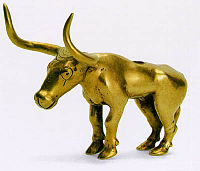- Maikop kurgan
-
The Maikop kurgan (also Maykop), excavated by Nikolay Veselovsky in 1897 near Maikop, Adygeja, Kuban, Southern Russia, is the eponym of the Early Bronze Age Maikop culture of the Northern Caucasus. Dating to the 3rd millennium BC, the kurgan had a height of about 10 m and a circumference of about 200 m. It revealed two burials, the central one with rich grave goods, including golden and silver bull figurines.
Literature
- Philip P. Betancourt, The Maikop Copper Tools and Their Relationship to Cretan Metallurgy, American Journal of Archaeology (1970).
- Philip L. Kohl, The Making of Bronze Age Eurasia, Cambridge World Archaeology (2007), ISBN 9780511266959, pp. 73ff.
- Brian Murray Fagan, The Oxford Companion to Archaeology (1996), ISBN 0195076184, p. 398.
See also
- Kurgan culture
- Kurgan hypothesis
- Bronze Age Europe
External links
- artefacts from the Maikop kurgan (metmuseum.org)

This article relating to archaeology in Europe is a stub. You can help Wikipedia by expanding it.

